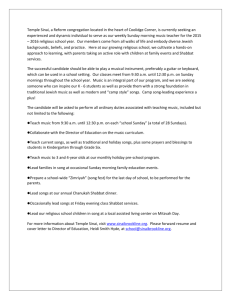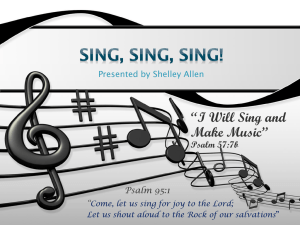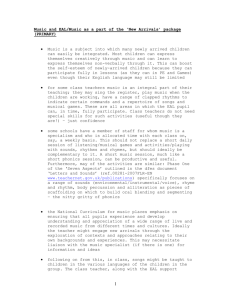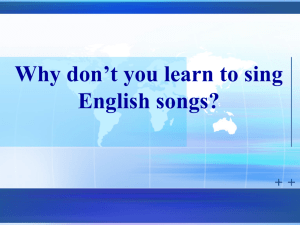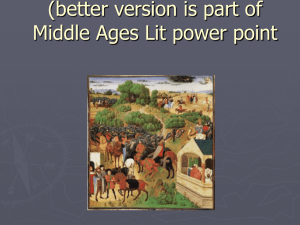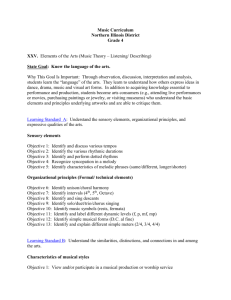Teaching Songs
advertisement
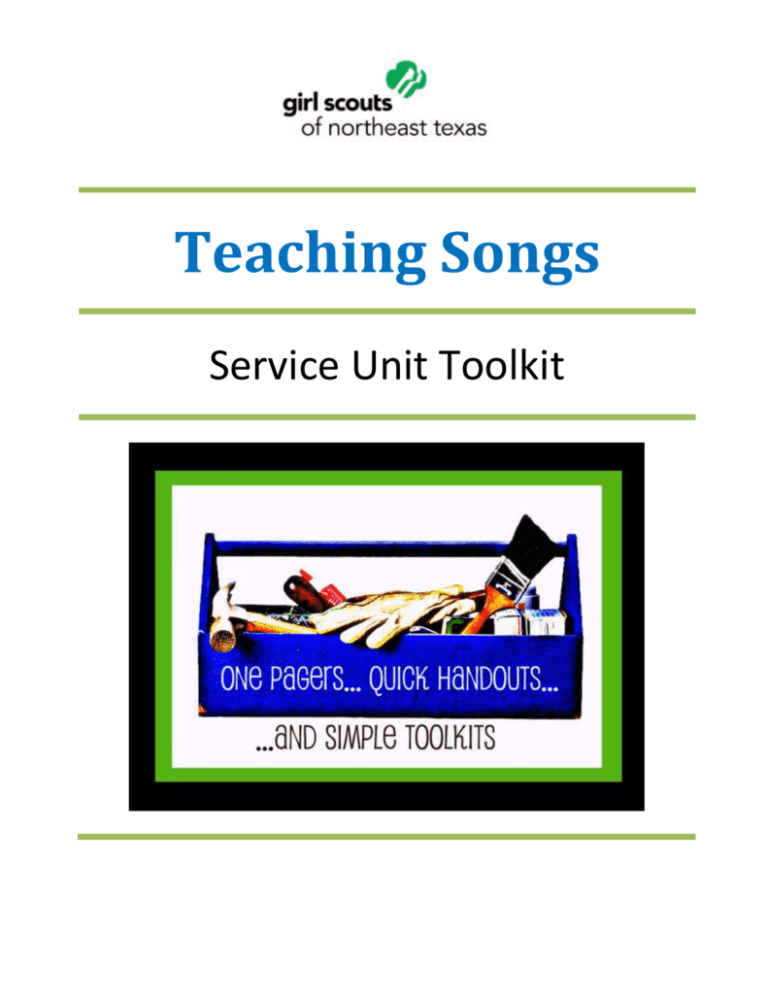
Teaching Songs Service Unit Toolkit Song Leading: A Skill That Can Be Learned Love to sing, but not sure how to start teaching others? Here are some great guidelines for the emerging song leader—no matter what age you are. Choosing Songs Know the group that you will be working with. How old are they? How many girls are there? What are their singing abilities? What are their song interests? How long is their attention span? Begin with simple songs or songs that the girls know. Choose songs that are simple, like short rounds, songs with tra-la-la choruses, repeat songs, or those that include repetition or choruses. Know what you are doing. Know the song words and the melody. Practice. Use note cards if you need them. Make a list of the songs you will sing, and know the order you will sing them in. Know something of the history of the song so you can share it with the girls. If you are choosing songs for an evening program, start out with rowdy songs and end with quiet songs to set the tone for bedtime. Teaching Songs Be enthusiastic. Demonstrate by example that singing together is not a competition to see who can sing the loudest. Encourage the group to listen to each other and to produce a beautiful sound. Sing the song through for the group. Introduce the song by telling where it is from. Sing the first verse and the chorus, so group members know how it sounds. Have those who know it sing with you. Teach the song phrase by phrase. Sing a phrase, and have the group sing back to you. Then join phrases and sing the verse and chorus. If long, teach a few verses, then repeat. Repeat once or twice. Sing the song all together. If singing a round, a song with parts, or a descant, make sure each group knows its part well before putting the parts together. If you are singing a song with parts, have a leader who knows each part. Use simple hand motions to keep the tempo. You give the starting note. Hum the melody or use a musical instrument. If you get it wrong, stop and start over. Avoid pitching too high or too low for girls. Make sure that girls follow your hand motions. Let them know that hand motions are used to keep the group together in the right tempo, and the motions will help them know where you are in the song. Choose a variety of songs. Do songs that are fast and slow, songs that include hand motions, and songs that lend themselves to simple harmony, as well as funny songs. Avoid songs that might be offensive to religious or ethnic groups. GSLE: Does it work with Singing? YES! Discover. Girls can share their favorite camp songs. They can list songs they remember from when they were younger. Are there songs that everyone knows? Are there songs that only one or two know? Make comparisons: Alike and Different, Cultures, Family memories and traditions. Connect. By singing together, girls connect their voices with others to make music. They connect with Girl Scouts and Guides worldwide by learning songs and their histories. Take Action. Singing is a way to communicate: values, passions, community, history. Leading songs and teaching them to younger (or older!) groups is a way to share with their community. Girl Led. Girls can create song lists for various activities. They can negotiate with each other and reach consensus on their choices. Girls can take turns leading songs for the troop. Work Cooperatively. Girls learn to listen for others’ voices; they learn to tune their singing to blend with the group. Learn by Doing. In The Music Man, Professor Harold Hill may have been on to something with his “Think Method” for learning music, but it’s probably truer that the only way to learn to sing is to SING! Resources Pax Lodge Songbook Sangam Sangeet/Sangam Songbook Girl Scout Pocket Songbook Girl Scout Brownie Songbook Check your Girl Scout council or camp library. There may be songbooks available for check-out. Campfire Songs, edited by Irene Maddox, Rosalyn Blankenship, and Rosalyn Cobb. Old Saybrook, Conn.: Globe Pequot Press. This has some fun songs. Rise Up Singing: The Group Singing Songbook, edited by Peter Blood and Annie Patterson. Bethlehem, Pa.: Sing Out! Publications. This is a favorite resource for folk songs. It has chords, but not the music, with words for over 1,000 songs. Girl Scouts Greatest Hits, Legend Music Web site at http://gsmusic.com. Information on recordings by Melinda Caroll (This CD is the result of a Girl Scout chorus). STEM – how about STEAM? Preparing our kids for the 21st century involves exciting them about STEM education and making sure they are literate in science, technology, engineering and math. Many are asking that we put an “A” for the Arts into STEM education, making STEAM education the focus of 21st century learning. That begs the questio n – does that mean that scientists, technologists, engineers and mathematicians need to learn design, beauty, and music? Steve Jobs made Apple a success focusing on design. Dan Pink, in his boo k A Whole New Mind: Why Right -Brainers Will Rule the Future , tells us that design is key to thriving in a future that belongs to a different kind of person with a different kind of mind: artists, inventors, storytellers -creative and holistic “right -brain” thinkers. Garr Reynolds, in Presentation Zen: Simple Ideas on Presentatio n Design and Delivery demonstrates how to seamlessly integrate design co ncepts into something as mundane as a PowerPoint. This approach looks at STEM education still in terms of silos of education. It asks if students interested in technolo gy, gifted in math and science, often labeled as geeks, will benefit from classes in calligraphy, design, piano, and dance. Or does putting the A in STEM mean that all students, even those in the arts, are meant to be immersed in this century’s needed STEM literacy? Are they learning the skills to use social media to connect with thousand s, like Eric Whitaker in co nducting a virtual choir, or the skills to story board, compose, enact and edit a light saber battle between with cello bows, or the skills to create a revolutionary peer -to-peer music file sharing pro gram like Shawn Fanning and Sean Parker, the co -founders of Napster? A popular approach to physics was intro duced several years ago at a music and STEM conference. It involves teaching an entire class the physics of pitch, frequency and resonance by building a guitar. The 21st century brings with it wonderful opportunities. Let’s be willing to learn new things and try new technology, to master more than o ne talent and collaborate with others to mash together new expressions of beauty, mourn and celebrate the music composed and performed in the past and boldly lead music in new directions that builds a more just and beautiful world. Taken from: http://www.ellencavanaugh.com/2012/07/05/musicstem -careers/ Where Can STEAM Lead?

